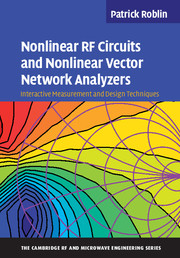 Nonlinear RF Circuits and Nonlinear Vector Network Analyzers
Nonlinear RF Circuits and Nonlinear Vector Network Analyzers Book contents
- Frontmatter
- Contents
- Preface
- Dedication
- Acknowledgments
- 1 Wireless signals
- 2 Large-signal vector measurement techniques with NVNAs
- 3 Device modeling and verification with NVNA measurements
- 4 Characterization and modeling of memory effects in RF power transistors
- 5 Interactive loadline-based design of RF power amplifiers
- 6 Behavioral modeling
- 7 Kurokawa theory of oscillator design and phase-noise theory
- 8 Design, modeling, and linearization of mixers, modulators, and demodulators
- 9 Linearization of RF power amplifiers with memory
- Index
- References
4 - Characterization and modeling of memory effects in RF power transistors
Published online by Cambridge University Press: 05 July 2011
- Frontmatter
- Contents
- Preface
- Dedication
- Acknowledgments
- 1 Wireless signals
- 2 Large-signal vector measurement techniques with NVNAs
- 3 Device modeling and verification with NVNA measurements
- 4 Characterization and modeling of memory effects in RF power transistors
- 5 Interactive loadline-based design of RF power amplifiers
- 6 Behavioral modeling
- 7 Kurokawa theory of oscillator design and phase-noise theory
- 8 Design, modeling, and linearization of mixers, modulators, and demodulators
- 9 Linearization of RF power amplifiers with memory
- Index
- References
Summary
This chapter discusses memory effects exhibited by transistors and how they affect their large-signal RF performance. Memory effects include self-heating, traps, and parasitic bipolar effects in SOI-MOSFETs. Distributed and transient thermal models will be discussed first. Large-signal measurement techniques for characterizing memory effects in transistors using pulsed biased and pulsed-RF large-signal measurements will be presented. Results from combined deep-level optical spectroscopy and large-signal measurement will then be introduced. Finally, the correlation between trapping and noise will be discussed. The chapter will conclude then with a discussion of the cyclostationary effect, according to which the average trapping population and device noise characteristics can be altered by the fast RF signals under large-signal RF operation.
Importance of memory effects in RF devices
GaN HEMTs provide a good example of devices strongly affected by memory effects. High-electron-mobility transistors (HEMTs) are among the most successful heterostructure three-terminal devices to have emerged over the last couple of decades [1]. GaN-based HEMTs show high transconductance, high cutoff frequencies, and good thermal management such that they are suitable for high-power and high-speed applications with minimal cooling [2] [3].
One of the obstacles for GaN HEMTs is current collapse or knee walk-out, which is known to result from the effects of surface trap states [4] [5] [6]. Many studies concerning the reduction of current collapse using various device processing techniques such as surface passivation, modified buffer layer designs, and field plates have been reported [3] [7].
- Type
- Chapter
- Information
- Nonlinear RF Circuits and Nonlinear Vector Network AnalyzersInteractive Measurement and Design Techniques, pp. 89 - 123Publisher: Cambridge University PressPrint publication year: 2011


